June, 1931
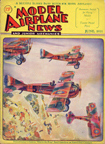
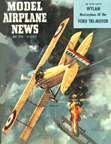
94th Aero Sqdn, Eddie Rickenbacker, SPAD S. VIII, and Battle of Cantigny
Model Airplane News Cover Art for June, 1931
by Jo Kotula
Click to Enlarge
This is a complex cover dealing with four topics: (1) the 94th Aero Sqadron, (2) Eddie Rickenbacker, (3) the Battle of Cantigny and (4) the SPAD S. VIII. Each of these will be discussed in that order.
94th Aero Squadron
The 94th Aero Squadron was the first American squadron at the front in World war I. It was comprised of two officers and 150 enlisted men. The group trained in Texas and was stationed at the Gengault Aerodrome near Toul, France. The aviators were allowed to create their squadron insignia and used this opportunity to commemorate the United States' entry into World War I. In boxing, "placing your hat in the ring" signify one's willingness to become a challenger. Thus, the 94th symbolized their desire to fight by adopting the image of Uncle Sam's red, white and blue top hat in a red ring.
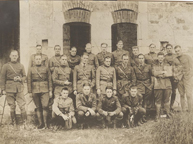
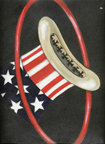
94th Aero Squadron Group Photo
The Hat-in-the-Ring Insignia
Click to Enlarge
On April 14, Lt. Douglas Campbell, who later became America's first flying ace, and Lt. Alan Winslow scored the first victories ever attained by an American unit, downing two German aircraft. More were to come as we follow the career of Eddie Rickenbacker.
While the American press lavished attention on the 94th, historical perspective reveals that they played only a small part in the aerial campaigns of the first World War. The British, French, Germans and Italians had been slugging it out in the air since 1914. The legend lives on; today popular restaurant chain, the 94th Aero Squadron, is named after the 94th from the First World War.
Click here to learn more about the 94th Aero Squadron.Eddie Rickenbacker
Edward Vernon Rickenbacker (October 8, 1890 – July 27, 1973) was an American fighter ace in World War I and Medal of Honor recipient. He was also a race car driver and automotive designer, a government consultant in military matters and a pioneer in air transportation, particularly as the longtime head of Eastern Air Lines. When, in 1917, the United States declared war on Germany, Rickenbacker had enlisted in the United States Army and was training in France with some of the first American troops. He arrived in France on June 26, 1917 as a Sergeant First Class. Because of his mechanical abilities, Rickenbacker was assigned as engineering officer in a flight-training facility at Issoudun, where he practiced flying during his free time. Eventually, he earned a place in the 94th Aero Squadron.
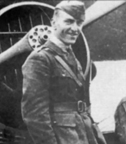
Eddie Rickenbacker in France, 1918
Click to Enlarge
On April 29, 1918, Rickenbacker shot down his first plane and claimed his fifth to become an ace on May 28. Rickenbacker was awarded the French Croix de Guerre that month for his five victories. He shot down Germany's hottest new fighter, the Fokker D.VII, on September 14 and another the next day. On September 24, 1918, now a captain, he was named commander of the squadron, and on the following day, he claimed two more German planes, for which he was belatedly awarded the Medal of Honor in 1931 by President Herbert Hoover. After claiming yet another Fokker D.VII on September 27, he became a balloon buster by downing observation balloons on September 28, October 1, October 27, and October 30, 1918. Rickenbacker's total of 26 victories remained the American record until World War II. However, Rickenbacker's 26 victories pale in comparison to Von Richtofen (Germany) with 80, Fonck (France) 75, Mannock (UK) 73, Bishop (Canada) 72, Little (Australia) 47, Jordan (South Africa) 39, Coppens (Belgium) 37, Brumowski (Austria) 35 or Baracca (Italy) 34. In fact, despite all the publicity, 105 aviators scored more victories than Rickenbacker. Nevertheless, he was awarded the Medal of Honor and was always a colorful figure in American aviation and made substantial contribution to the advancement of commercial aviation and in goading the American public into preparedness for World War II.
Here is a video about Eddie Rickenbacker:
Click here to learn more about Eddie Rickenbacker.
Battle of Cantigny
The Battle of Cantigny, fought on 28 May 1918, was the first American offensive of World War I, and hence its memorialization on the cover of M.A.N.
The 28th Infantry Regiment of the U.S. 1st Infantry Division (3,564 troops), under Major-General Robert Lee Bullard, captured the village of Cantigny from the German Eighteenth Army commanded by von Hutier. The village was situated on high ground surrounded by woods, making it an ideal target for German artillery. Aiding the capture, the French provided air cover, 368 heavy guns, trench mortars, and flamethrowers. The advancing American infantry was aided by twelve French Schneider tanks used to eliminate German machine gun posts. With this support, and advancing much more audaciously than expected, the 28th Infantry took the village in 45 minutes. For three days after the capture of the village, the Germans launched heavy counterattacks upon the Americans. Another regiment, the 26th Infantry, came forward to support the 28th. The position was held. The Americans expanded their front by approximately a mile. A minor success, its significance was overshadowed by the battle underway along the Aisne. The U.S. forces held their position with the loss of 1,067 casualties; they captured 100 German prisoners.
The SPAD S. XIII
The SPAD S.XIII was a French biplane fighter aircraft of World War I, developed by Société Pour L'Aviation et ses Dérivés (SPAD - might be translated as "Airplanes'R'Us") from the earlier highly successful SPAD S.VII. It was one of the most capable fighters of the war, and one of the most-produced, with 8,472 built and orders for around 10,000 more cancelled at the Armistice.
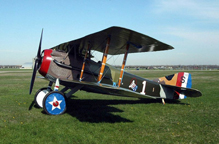
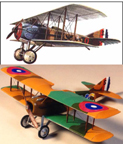
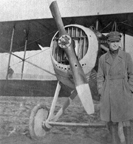
SPAD S. XIII
Georges Guynemer with his SPAD S. XIII
Click to Enlarge
The S.VII had entered service in September of 1916, but was surpassed by the latest German fighters in only a few months. French flying ace, Georges Guynemer began lobbying for an improved version, calling for more speed and more firepower. SPAD designer Louis Béchereau first began to explore arming an airplane with a 37 mm cannon, and produced the S.XII. However, the wight associated with the cannon and engineering requirements needed to make it work resulted in a slower plane that was hard to fly. The only pilot able to master the S. XII did achieve seven victories. It appeared that speed was the most important factor and thuis was botn the S.XIII.
The S.XIII differed from its predecessor by incorporating a number of aerodynamic and other refinements, including larger wings and rudder, a more powerful engine and a second gun. It was faster than its main contemporaries, the British Sopwith Camel and the German Fokker D.VII, and was renowned for its ruggedness and strength in a dive. It had poor maneuvrability, especially at low speeds. It was a difficult aircraft for novice pilots to land safely.
Here is a video of a restored SPAD S. XIII in action:
Click Here for more information about the SPAD S. XIII.
This was a popular Cleveland kit because Eddie Rickenbacker was a war hero and a colorful public figure. (You'll note that Rickenbacker's name is on the box.
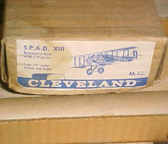
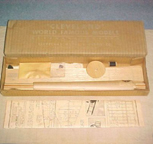
Cleveland Model
Click to Enlarge
You can buy the plans and patterns that will enable you to make this model right now. Click Here to go to the exact location on the Cleveland Website to get them.

The SPAD S.XIII at the Cleveland Site
Click to Enlarge

Click to go back and select another cover.
Counter for the Entire Site (not just this page..)
Home | About Lindy | Last Week's Reviews | Upcoming Events | 1940s Collecibles
The Guide - Establishments - Travel - Accessories
Music | Links | Photo Gallery | Extras | Contact